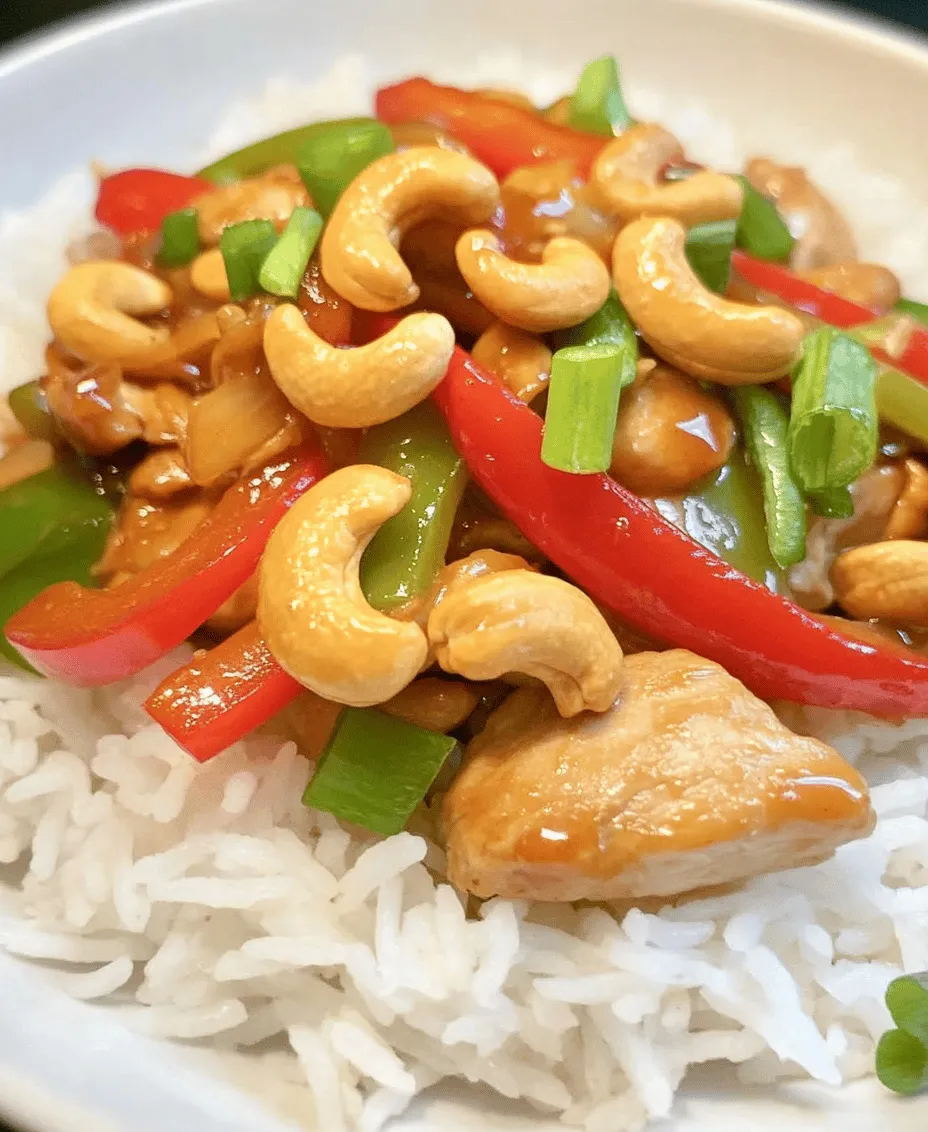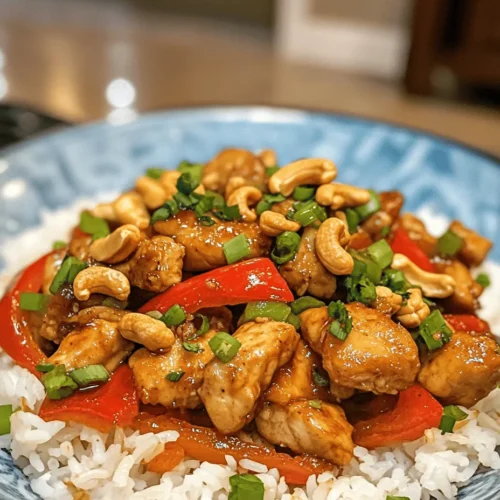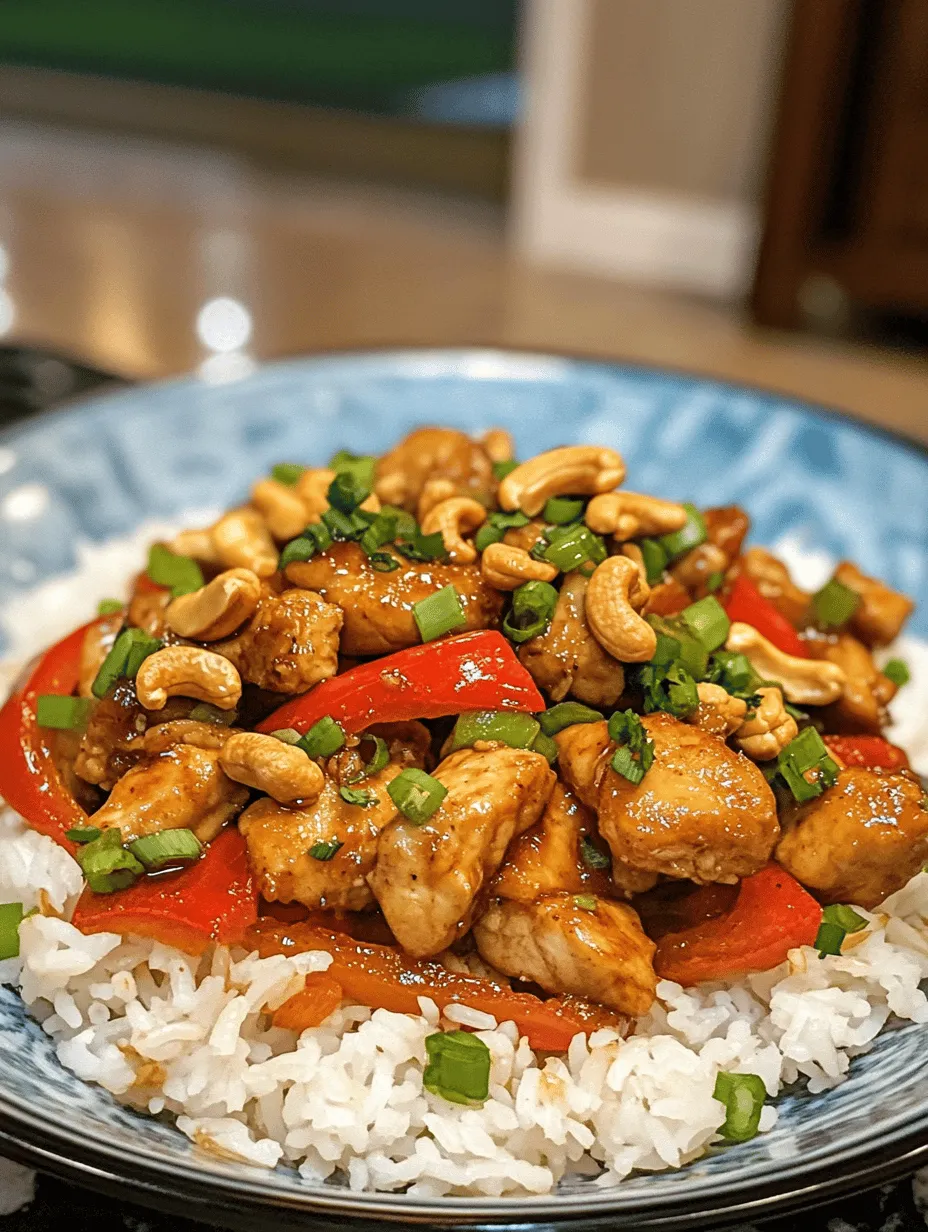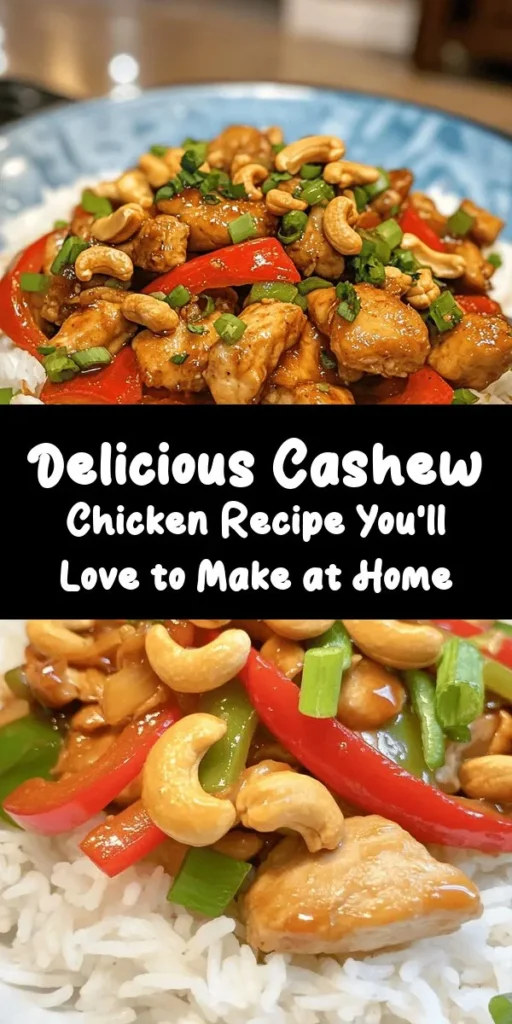Introduction
In today’s fast-paced world, takeout has become a beloved staple for many families and individuals. The convenience of ordering a delicious meal with just a few clicks provides an immediate satisfaction that is hard to resist. However, while takeout dishes offer a quick fix for hunger, they often come with hidden downsides like high sodium, unhealthy fats, and a lack of freshness. This is where the idea of recreating those favorite takeout meals at home comes into play.
Imagine savoring the rich flavors of your go-to Asian takeout meal, but with the added benefits of healthier ingredients, customized flavors, and the satisfaction of making it yourself. One dish that stands out in the realm of homemade takeout favorites is Cashew Chicken. This dish encapsulates the essence of a quick and satisfying meal, boasting a delightful combination of crunchy cashews, tender chicken, and vibrant vegetables.
In this article, we will explore the nuances of making Better-Than-Takeout Cashew Chicken. With its perfect balance of savory and slightly sweet flavors, this dish not only pleases the palate but also allows for versatility in preparation. Whether you’re cooking for a family dinner, a casual gathering, or simply craving a delicious meal, Cashew Chicken is sure to impress.
Understanding Cashew Chicken
Historical Context in Asian Cuisine
Cashew Chicken has roots that trace back to Chinese cuisine, specifically originating from the southern regions of China, where cashew nuts are abundant. Over the years, this dish has evolved and adapted to various culinary cultures, particularly in Western countries, where it has become a popular menu item in Chinese-American restaurants. The dish typically features stir-fried chicken combined with cashews and a colorful array of vegetables, all coated in a flavorful sauce that tantalizes the taste buds.
What makes Cashew Chicken unique is its harmonious blend of textures and flavors. The crunch of the cashews complements the tender, juicy pieces of chicken, while the fresh vegetables add a vibrant touch both visually and in taste. This combination not only appeals to the senses but also highlights the versatility of Asian cooking, where balancing flavors and textures is paramount.
Core Flavors and Textures
At the heart of Cashew Chicken are its core components: crunchy cashews, juicy chicken, and an assortment of crisp vegetables. The cashews lend a nutty flavor and a satisfying crunch, while the chicken thighs deliver a rich, savory taste. The addition of colorful bell peppers, onions, and sometimes carrots or broccoli introduces freshness and a slight sweetness, making each bite a delightful experience.
The sauce that binds these ingredients together typically features soy sauce, oyster sauce, and a hint of sweetness, creating a complex umami flavor profile. When prepared correctly, Cashew Chicken is a symphony of flavors—rich, savory, and subtly sweet—making it a crowd-pleaser for all ages.
Nutritional Benefits of Key Ingredients
Not only is Cashew Chicken delicious, but it also offers numerous nutritional benefits. The primary ingredient, boneless, skinless chicken thighs, is favored for its flavor and juiciness, providing a good source of protein. Unlike chicken breasts, thighs tend to be more forgiving during cooking, remaining moist and tender even if slightly overcooked.
Cashews, the star nut of this dish, are rich in healthy fats, protein, and essential nutrients like magnesium, copper, and manganese. These nutrients contribute to heart health and may help in managing blood sugar levels. Additionally, the vegetables used in Cashew Chicken—such as bell peppers and onions—are packed with vitamins, antioxidants, and dietary fiber, promoting overall health and wellness.
Moreover, the use of soy sauce and oyster sauce introduces beneficial amino acids that enhance the dish’s nutritional profile while packing a flavorful punch. Including aromatics such as garlic and ginger not only elevates the taste but also offers anti-inflammatory properties and boosts the immune system.
Ingredients Breakdown
To create a truly delicious Better-Than-Takeout Cashew Chicken, it’s essential to understand the role of each ingredient. Below is a detailed description of the necessary components and their contributions to the final dish:
Boneless, Skinless Chicken Thighs
Choosing boneless, skinless chicken thighs instead of breasts is a game changer for this recipe. Thighs are more flavorful due to their higher fat content and remain juicy even after cooking. They are also less prone to drying out, making them an ideal choice for stir-frying. The texture of chicken thighs complements the crunchy cashews perfectly, adding a depth of flavor that enhances the overall dish.
Cashews
Cashews are the centerpiece of this dish, bringing a unique flavor and texture. They add a delightful crunch and a slightly sweet, buttery taste that pairs wonderfully with the savory elements of the recipe. Nutritionally, cashews are an excellent source of healthy fats, vitamins, and minerals, making them a wholesome addition to any meal. To achieve the best flavor, use unsalted, roasted cashews, which will enhance the dish without overwhelming it with salt.
Soy Sauce and Oyster Sauce
Soy sauce is a staple in Asian cooking, known for its salty and umami-rich profile. It provides the foundational flavor for the sauce in Cashew Chicken. Oyster sauce, made from oyster extracts, adds a touch of sweetness and depth, creating a balanced flavor that complements the other ingredients. Together, these sauces create a savory base that enhances the overall taste of the dish.
Cornstarch
Cornstarch plays a crucial role in achieving the desired texture for Cashew Chicken. It is often used to coat the chicken before stir-frying, creating a crispy exterior while locking in moisture. This technique not only elevates the texture but also helps to thicken the sauce, ensuring a cohesive and flavorful coating for the chicken and vegetables.
Vegetables (Onion and Bell Peppers)
The choice of vegetables is vital in adding color, flavor, and nutritional value to Cashew Chicken. Sliced onions and bell peppers are commonly used, as they offer a sweet and crunchy contrast to the other ingredients. Bell peppers, in particular, come in various colors—red, yellow, and green—adding visual appeal and a range of vitamins. Including these vibrant vegetables not only enhances the dish’s aesthetic but also boosts its health benefits.
Aromatics (Garlic and Ginger)
Garlic and ginger are essential aromatics that elevate the flavor profile of Cashew Chicken. Garlic adds a pungent, savory note, while ginger contributes warmth and a hint of spice. Together, these ingredients create a fragrant base that enhances the overall dish and adds a layer of complexity to the flavors. Their health benefits are a bonus, as they possess anti-inflammatory properties and can aid in digestion.
Hoisin Sauce, Rice Vinegar, and Sesame Oil
These additional ingredients bring balance to the dish. Hoisin sauce introduces a sweet and tangy element, enhancing the overall flavor while providing a glossy finish to the dish. Rice vinegar adds acidity, cutting through the richness of the sauces and balancing the sweetness. Finally, a drizzle of sesame oil at the end of cooking adds a nutty aroma and flavor that ties everything together beautifully.
Preparation Steps
Now that you have a solid understanding of the history, ingredients, and nutritional benefits of Cashew Chicken, let’s dive into the preparation steps that will guide you through creating this mouthwatering dish at home.
1. Prepare the Ingredients: Start by gathering all your ingredients. This includes boneless, skinless chicken thighs, cashews, soy sauce, oyster sauce, cornstarch, and your choice of vegetables (such as bell peppers and onions). Chop the vegetables into bite-sized pieces and slice the chicken thighs into uniform strips for even cooking.
2. Marinate the Chicken: In a bowl, combine the sliced chicken with soy sauce and a tablespoon of cornstarch. This marinade will not only flavor the chicken but also help create that desirable crispy texture when cooked. Let the chicken marinate for at least 15-20 minutes while you prepare the other ingredients.
3. Prepare the Sauce: In a separate bowl, whisk together oyster sauce, hoisin sauce, and rice vinegar. This mixture will serve as the flavorful sauce for your Cashew Chicken, bringing together the umami, sweetness, and acidity that make this dish so appealing.
4. Stir-Fry the Chicken: Heat a large skillet or wok over medium-high heat and add a tablespoon of oil (such as vegetable or canola oil). Once the oil is hot, add the marinated chicken in a single layer. Allow it to cook undisturbed for a few minutes until browned and crispy on one side, then stir-fry until fully cooked. Remove the chicken from the pan and set it aside.
5. Sauté the Aromatics and Vegetables: In the same pan, add a bit more oil if necessary, then toss in minced garlic and ginger. Sauté for about 30 seconds or until fragrant. Next, add the sliced onions and bell peppers, and stir-fry until they are tender-crisp, about 3-4 minutes.
6. Combine Ingredients: Once the vegetables are ready, return the cooked chicken to the skillet. Pour the prepared sauce over the chicken and vegetables, stirring to coat everything evenly. Allow the mixture to simmer for a few minutes, letting the flavors meld and the sauce thicken slightly.
7. Add Cashews: Just before serving, fold in the roasted cashews, ensuring they are evenly distributed throughout the dish. The cashews should remain crunchy, providing that satisfying texture contrast.
These steps will guide you through creating a flavorful and satisfying Better-Than-Takeout Cashew Chicken that is sure to impress. With its combination of tender chicken, crunchy cashews, and vibrant vegetables, this dish offers all the comfort of takeout while providing a healthier and homemade alternative.
Stay tuned for the next section, where we’ll discuss tips for achieving the best results and answer some common questions about this delicious recipe!

Marinating the Chicken
Marinating the chicken is a pivotal step in achieving the rich, complex flavors associated with authentic cashew chicken. The process allows the chicken to absorb the marinade’s ingredients, resulting in a more flavorful dish. For this recipe, a simple marinade of soy sauce, garlic, ginger, and a touch of sesame oil will infuse the chicken with a savory depth that complements the cashews beautifully.
To marinate the chicken effectively, cut it into bite-sized pieces, which increases the surface area for flavor absorption. Place the chicken in a bowl or a resealable plastic bag, add the marinade, and ensure all pieces are well coated. Allow it to marinate for at least 30 minutes; if time permits, marinating for a few hours or overnight will yield even better results. This process not only enhances the flavor but also tenderizes the chicken, leading to a more enjoyable texture once cooked.
Stir-Frying the Cashews
Achieving the perfect toasted flavor in cashews is essential as it contributes significantly to the overall taste of the dish. Start by heating a dry skillet over medium heat. Once hot, add the raw cashews in a single layer. Stir them frequently to ensure even toasting and prevent burning. This process should take about 3-5 minutes. You’ll know they are ready when they turn a golden-brown color and emit a rich, nutty aroma.
To enhance their flavor further, consider adding a pinch of salt or even a sprinkle of smoked paprika during the last minute of cooking. Once toasted, remove the cashews from the skillet and set them aside to cool. This step is crucial, as adding them to the dish too early can result in soggy nuts instead of the delightful crunch you want.
Cooking the Chicken
Cooking the marinated chicken to perfection is key to a successful cashew chicken dish. Start by heating a tablespoon of oil—preferably vegetable or peanut oil—in the skillet over high heat. The high temperature is essential for searing the chicken quickly, locking in moisture, and achieving that coveted golden-brown crust.
Add the marinated chicken to the skillet in a single layer, ensuring not to overcrowd the pan, which can cause steaming rather than frying. Allow the chicken to cook undisturbed for about 3-4 minutes before flipping it to ensure a nice sear develops. Cook for an additional 3-4 minutes or until the chicken is cooked through and reaches an internal temperature of 165°F (75°C). After cooking, remove the chicken from the skillet and let it rest for a couple of minutes before adding it back to the dish.
Stir-Frying Vegetables
Maintaining the crunch and vibrant color of the vegetables in your cashew chicken recipe is essential for both texture and presentation. After the chicken is cooked, use the same skillet to stir-fry your choice of vegetables. Bell peppers, broccoli, and snap peas are excellent options, offering a balance of sweetness and crunch.
Add a bit more oil to the skillet if necessary and increase the heat to high. Add the vegetables in the order they require the most cooking time—start with the bell peppers, followed by broccoli, and lastly, snap peas, which only need a minute or two. Stir-fry the vegetables for about 4-5 minutes, keeping them moving in the pan to ensure they cook evenly without losing their vibrant color and crispness. The goal is to achieve a tender-crisp texture, where the vegetables are still bright and maintain a slight crunch.
Combining Ingredients
Creating the perfect sauce consistency is where the dish really comes together. After the vegetables have been stir-fried, return the cooked chicken to the skillet. In a separate bowl, mix together the sauce ingredients, which typically include soy sauce, oyster sauce, a bit of cornstarch mixed with water for thickening, and a hint of sugar to balance the flavors.
Pour the sauce over the chicken and vegetables in the skillet. Stir everything together, allowing the sauce to coat each piece evenly and thicken slightly as it heats. This should only take a few minutes. Finally, fold in the toasted cashews, ensuring they are evenly distributed throughout the dish. The result should be a beautifully glazed chicken and vegetable mixture, rich in flavor and enticing in appearance.
Serving Suggestions
When it comes to serving your Better-Than-Takeout Cashew Chicken, there are several ideal accompaniments that elevate the dish. Jasmine rice is a classic choice, providing a fragrant and fluffy base that pairs perfectly with the savory flavors of the chicken and sauce. Alternatively, quinoa offers a nutritious, protein-packed option with a slightly nutty flavor that complements the dish well.
For an appealing presentation, consider garnishing your cashew chicken with chopped green onions and a sprinkle of sesame seeds. These accents not only enhance the visual appeal of the dish but also add a fresh crunch and extra flavor. If you’re feeling adventurous, try adding sliced red chili peppers for a spicy kick.
Possible Variations
One of the joys of making cashew chicken at home is the ability to customize it to your preference. Feel free to experiment with different vegetables based on what you have on hand or what’s in season. Sugar snap peas, bok choy, and even mushrooms can add unique flavors and textures.
If you want to switch things up protein-wise, consider substituting the chicken with shrimp, tofu, or even beef for a different take on this classic dish. Each variation allows for a new experience while still delivering that familiar, comforting taste.
Nutritional Information
Understanding the nutritional content of your homemade cashew chicken can be enlightening, especially when compared to traditional takeout options. Typically, a serving of homemade cashew chicken (about 1 cup) contains approximately 350-400 calories, depending on the specific ingredients used.
In terms of macronutrients, you can expect around 20-25 grams of protein, 15-20 grams of fat (most of which comes from the cashews), and around 25 grams of carbohydrates. This is a significant reduction in calories, fat, and sodium compared to many restaurant versions, which can easily exceed 800 calories per serving and contain high levels of sodium and preservatives.
Benefits of Homemade Cashew Chicken
Cooking at home offers numerous advantages, particularly when it comes to controlling the ingredients in your meals. By making cashew chicken yourself, you can choose high-quality chicken and fresh vegetables, avoiding the preservatives and excess sodium commonly found in takeout versions.
Moreover, preparing this dish at home can be more cost-effective than ordering from a restaurant. While takeout may seem convenient, the expenses can quickly add up, especially for families or frequent diners. Cooking at home not only saves money but also allows for greater creativity and customization in your meals.
The health benefits of making cashew chicken from scratch are significant. You can reduce unhealthy ingredients, adjust the sodium levels, and tailor the flavors to suit your palate, resulting in a dish that is both delicious and nutritious.
Conclusion
In summary, making Better-Than-Takeout Cashew Chicken at home is not only achievable but also incredibly rewarding. The process allows you to explore various flavors and textures while creating a meal that rivals your favorite restaurant versions. With easy-to-follow steps, you’ll find that preparing this dish is both satisfying and enjoyable.
Take the plunge and try your hand at this delightful recipe. Experience the joy of cooking and the satisfaction of enjoying a homemade meal that is bursting with flavor. Your kitchen can quickly become a hub of deliciousness, and who knows? You may find this dish becoming a staple in your home-cooked repertoire.



